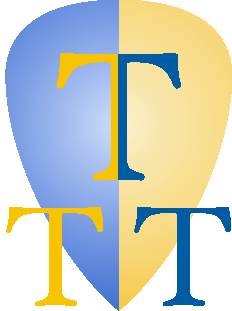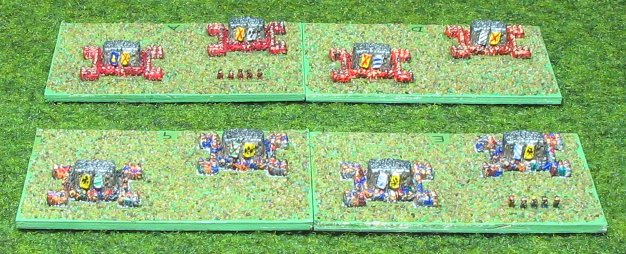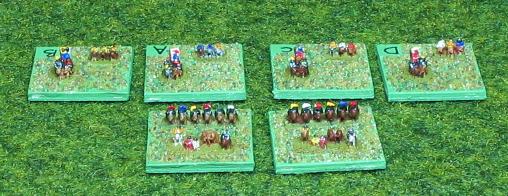|

|
2mm
Renaissance Principles of War |
 |
|
The first Principles of War
(PoW) rules that I came across were the original Napoleonic set. I wasn't
really looking for them in particular but they looked interesting, were
well presented and immediately struck me as being a strong possibility for
use with 2mm. Napoleonics are not a main interest of mine and the armies
never got built but they did make me buy the Renaissance rules when I saw
them at a show.
My main interest in history
has always been the Medieval period and when I looked for some decent
rules to extend this interest into the Renaissance I couldn't find much
that suited me at all. Too many rules were very limited in time span (ECW
rules abound) and I wanted something with more scope and variety.
Ren PoW seemed to fit all my
requirements pretty well :
-
They cover a wide period
: 1494-1660
-
They are element based :
for 2mm this is an essential feature
-
The rules are well
written; not perfect, but better than average
-
There is enough
explanation to 'get the feel' of the author's view of the period
-
They have an active
discussion group of the Internet
-
They were reasonably
priced : £12 I think
|
|
Bases
-
The base sizes are reduced in to 2/3rds original size. The standard
90mm frontage becomes 60mm.
All but the Tercio bases are 20mm deep. I
did consider reducing to 40mm to make them compatible with the DBA
bases but rejected it as impractical, I needed the space for more
variety in the layout of the bases.
-
The bases are made from a dense and rigid card
glued (with PVA or Evo-Stik) onto magnetic sheet (for ease of storage and transport).
-
The texturing is actually
coloured sand (sprinkled onto thinned PVA) over the painted base.
-
Each base has a small
letter at the rear (just visible in some photos) to identify the base.
This is necessary because bases of a type may have different
characteristics.
|
|
Base Layout
-
I wanted to be able to
fight across as much of the period as possible without having lots of
separate armies. In 2mm the use of generic elements is quite feasible,
it may not always look historical but it isn't too difficult to
accept.
-
I wanted the different
element types to be distinguishable and to have some variety within
each type for the various sub-types needed.
-
Where possible I have also
attempted to make the base into a bit of a diorama so that it actually represents
the 'look' of the troop type.
-
As I already had a
significant number of blocks already painted I was a bit limited in
the blocks I used and this has resulted in some less than perfect base
layouts and some rather bizzare colour schemes.
|
|
The results below are the
elements built so far. They cover much of the period but concentrate upon
the western continental armies up to the 30 Years War. The next step is to
fill in a few gaps and then extend to cover eastern Europe and the
Ottomans.
I have tried to explain my
layouts and detail which blocks I used.
The illustrations are
arranged by the troop classifications used in Ren PoW.
The photos haven't come out
that well as I took them quickly in poor lighting, I'll get around to
doing some better ones one day.
|
|
Class 1 : Artillery
- Skirmishers
|
|
Below : European
Artillery (Ea)
- Use either
ABG1 or ABG2
The light artillery (4
guns) has a mix of RBG26, 27 & 28 and the Heavy (3 guns) mostly RBG 29
with an odd RBG28.
These look a bit bare, maybe
I should have added some wagons or horse teams.
|

|
|

|
|
Above : Skirmish Firepower (Sf)
All these use
about 3 blocks of dismounted dragoons (RBG11). Some are cut into smaller
strips, it is quite easy to do with this block. The two different
arrangements allow for two different kinds of weapon (Bow, Arquebus or
Musket) to be used in the same army.
Below : Skirmish
Firepower Mounted (Sf Mtd)
These use the mounted
dragoon (RBG22) with one variant having some dismounted ones too.
These represent the mounted
crossbows and arquebusier that seem to have been quite common in the
earlier part of the Renaissance.
|
|

|
|
Below : Skirmish Melee (Sm
Mtd)
I used the Cossack figure
(BG18) for these, a nice block and easy to cut up into individual figures.
These represent units such
as Stradiots, Spanish Genitors or English Border Horse.
|

|
|
|
Class 2 : Firepower
Troops
|

|
|
Above :
Firing Foot (Ff)
These use a
mixture of blocks. The two on the right are 3 x ABG24 (loose order bowmen),
a poorly detailed block but they look a bit like the looser formation that
both crossbowmen and early arquebusier used. The front left uses 2 ABG24 and
2 RBG12 and the rear right has RBG11.
The differences
are needed to represent the different types of weapon used.
I would have
liked to make these bases more densely packed but didn't have enough of the
right types in stock.
Below :
Reiter (Re)
This is one of
the three elements that use a 20mm square base, just about enough room for a
single 3-rank RBG21.
These represent
those horse in deep formations that used the caracole.
|

|
|
|
|
|
Above :
Commanded Shot (Cs)
Haven't done
any of these yet but will probably use a single BG31 (6-rank infantry).
Below :
Dragoons (Dr)
Still haven't
done these either but I will probably use a mix of RBG11 and RBG22.
|
|
|
|
|
Class 3 : Mixed
Tactic Troops
|

|
|
Above :
Tercio
These are on a
deeper base (40mm instead of 20mm) and I feel that it looks better to have 2
Tercio blocks (RBG10) per base. To further difference elements I did half
with a single strip of dismounted Dragoons (RBG11) to represent the
skirmishing shot.
|
|

|
|
Above : Pike
& Shot 2:1 (P:S 2:1)
Ideally I would
have used the large pike blocks (RBG9) for this element but I had run out of
them and I did have a lot of the very small pike blocks (6 off either RBG34
or ABG17) already painted so I used those. The shot are 2xRBG12 + 2xRBG11.
These represent
units such as the Spanish Collunellas and the earliest French regiments.
Below : Pike
& Shot 1:1 (P:S 1:1) This
represents a wide variety of tactical deployments but I based this roughly
on the Maurician model with the shot (RBG12) to the front of the pikes
(RBG33) and the battalion arranged in two halves. I could probably have done
with some variants on this element but I ran out of appropriate blocks
before I thought of it. Most
of the pike & shot units from about 1600-1640 are of this type except
where they stick to the older Tercio tradition. Even Swedish units are this
type though my personal opinion is that the best Swedish units would be best
modeled as P:S 1:2.
|

|
|

|
|
Above : Pike
& Shot 1:2 (P:S 1:2)
This seemed the
only element that I could use the actual pike & shot blocks for (RBG1-7)
and so I used all the ones I had already painted and ended up with more than
I need. It occurred to me that I could just as easily use these as P:S 1:1.
The variant on the right, with the (not very clear) small gun (BG20) represents the Swedish with a
battalion gun.
These represent
the final form of the Pike/Shot combination with a small proportion of pikes
and better armed and trained shot.
|
|

|
|
Above :
Trotters
Each base uses
3 blocks of either RBG19 or RBG21 in 2 slightly different arrangements.
These represent
those horse that advanced more slowly than the Gallopers and used their
pistols either just before contact or during the melee.
Below :
Tribal Foot
Not a common
type and none done as yet.
|
|
|
|
|
|
|
Above :
Janissaries
Still to do
these. There will be two types, one representing the Ottoman Janissaries and
their imitators and the other the Tudor English Bill & Bow. Not yet sure
what I will use for these.
Below :
Sipahi
Still to do
these. I will probably use the Cossacks because I have got lots of them.
|
|
|
|
|
Class 4 : Hand Combat
Troops
|

|
|
Above :
Melee Foot
Uses 3 x BG16 -
not a very satisfactory solution but I only needed a few and these were
already painted. I will need other types here so I need to look at these
again.
These represent
foot armed only with melee weapons that are not pikes. English Bills, French
Partizan men and Spanish Sword & Buckler
Below : Pk
These are the
final type on the smaller base and use one of each variant of RBG9. A few
bases have a couple of dismounted dragoons as well to difference them. These
are the Swiss and Landsknechts.
|

|
|

|
|
Above :
Gallopers (Ga)
The two types
are : front and left rear - Gens d'Armes (4 x RBG14 or you could use either
RBG13 or 15 plus 1 or 2 command BBG24) and right rear - later
'hard-charging' horse (Swedes, English Royalists etc.) 3 blocks of RBG16, 18
or 20).
Represents
horse that relied principally on the impact of their charge.
|
|
|
Class 5 : Elite
Troops
|
|
These are
special classes of Gallopers and Pikes and will use the appropriate bases of
those types.
|
|
|
Commanders
|
|
Each army generally has a CinC and two other
commanders.
|

|
|
|
Back to the top
of the page |